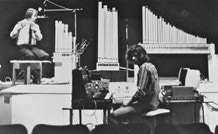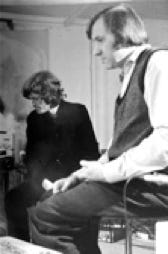

with the flutist Eberhard Blum and sound objects by Martin Riches 1984

SprachMusik for alto flute and voice, Talking Machine and computer (2006-2008):
SprachMusik is a composition in which the flutist, who uses both voice and alto flute, interacts with Martin Riches' Talking Machine via a computer.
Pitch, volume and sound spectrum of her voice and her flute sounds control sound production and structures of the mechanical, electrically controlled talking machine.
This machine, invented and built by Martin Riches, functions as a sound object in exhibitions.
He did not construct this machine to document the latest technological state of the art. The machine rather forms a somewhat ironic contrast to progress believing positivism by being based on construction principles of the 18th/19th century. In this negation it is a work of art in the best sense.
In our case, it serves as a musical-theatrical partner to the flutist.
In 2006, Martin Riches and I had the opportunity to work on this communication system for several months as 'artists in residence' of the Tesla in the Podewilschen Palais in Berlin.
In this way, many initially hidden properties of the machine could be crystallized. Especially mechanical sound generators like this speech machine have a life of their own, especially in the peripheral areas, which gives them a high authenticity as arbitrary, surprising, non-interchangeable objects.
In SprachMusik, a libidinous relationship between man and machine is revealed.
Since there are no loudspeaker sounds to be heard, a pure confrontation of two 'unfiltered' partners emerges.
Different characters of both appear: dominance, vulnerability, togetherness, brutality, voluntary and involuntary irony.
Speech patterns such as whispering, breathing, slurring, stuttering, jabbering show emotional aspects, structural modes such as articulate/inaarticulate, emerging/dying, abrupt/soft are used to form shapes.
The machine, whose sounds at first seem to have no musical suitability, becomes a musical tool via linguisticity, its disturbance and uncertainty, which shows many shades from interlaced rhythm to disreputable fundamental tones.
Its individual sound generators form English speech sounds, which in this composition serve to form a kind of art language that emerges and crumbles in its rudimentary beginnings. It is reduced to a few words.
Almost all of the rhythmic elements result from a speech rhythm created by the superimposition of words. The structures range from short sentence fragments to single words to rotating, machine-like sequences that are created or disrupted.
Conscientious "humanizing" methods of the machine are contrasted with "dehumanizing" alienations of the musician.
